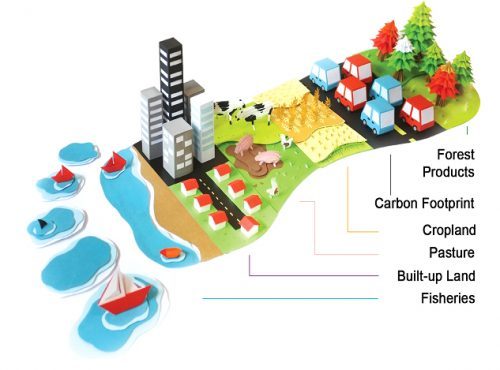What is the Ecological Footprint?
Humans need food, shelter and heating (in some locations) to survive. Our planet’s ecological resources help fulfill these needs. But how many resources do we consume? This question can be answered using the Ecological Footprint.

Source: WWF Japan and Global Footprint Network; Ecological Footprint for Sustainable Living in Japan
Just as a bank statement tracks income against expenditures, Ecological Footprint accounting measures a population’s demand for natural ecosystems’ supply of resources and services.
On the demand side, the Ecological Footprint measures an individual or a population’s demand for plant-based food and fiber products, livestock and fish products, timber and other forest products, space for urban infrastructure, and forest to absorb its carbon dioxide emissions from fossil fuels.
On the supply side, a city, state, or nation’s biocapacity represents its biologically productive land and sea area, including forest lands, grazing lands, cropland, fishing grounds, and built-up land.
The Ecological Footprint can be calculated for a single individual, city, region, country and the entire planet. It is also relevant for companies.
The gap between Ecological Footprint and biocapacity is determined by several factors. Our personal Footprint is the product of how much we use and how efficiently this is being produced. The biocapacity per person is determined by how many hectares of productive area there is, how productive each hectare is, and how many people (in a city, country, or the world) share this biocapacity.
Many countries are “in the red,” which means they use more natural resources (Ecological Footprint) than their ecosystems can regenerate (biocapacity). They are running an “ecological deficit.” When a country’s biocapacity is greater than its population’s Ecological Footprint, on the other hand, the country boasts an “ecological reserve.”
Nations (also cities and states) can run ecological deficits by liquidating their own resources, such as by overfishing; importing resources from other areas; and/or emitting more carbon dioxide into the atmosphere than their own ecosystems can absorb.
What is Earth Overshoot Day?
When the entire planet is running an ecological deficit, we call it “overshoot.” At the global level, ecological deficit and overshoot are the same, since there is no net import of resources to the planet.
Overshoot occurs when:
HUMANITY’S ECOLOGICAL FOOTPRINT > EARTH’S BIOCAPACITY
Earth Overshoot Day marks the date when humanity’s demand for ecological resources and services (Ecological Footprint) in a given year exceeds what Earth can regenerate in that year (biocapacity).
Where does the data come from?
Your country has offices that collect data about the country’s economic activities, agricultural productivity, imports and exports, energy consumption, etc. These data allow us to calculate how much food (apples, pasta, orange juice) has been eaten, how much wood used to make furniture, how much energy households use and so on. These offices report the data to international agencies, including the United Nations, that distribute this information in consistent formats for most countries in the world. FoDaFo is the organization dedicated to govern the National Footprint and Biocapacity Accounts, which provide the results of the Ecological Footprint and the biocapacity for more than 200 countries. Those accounts use this UN data published by these international offices and applies them to its comprehensive accounting database to calculate how many resources each country consumes.
